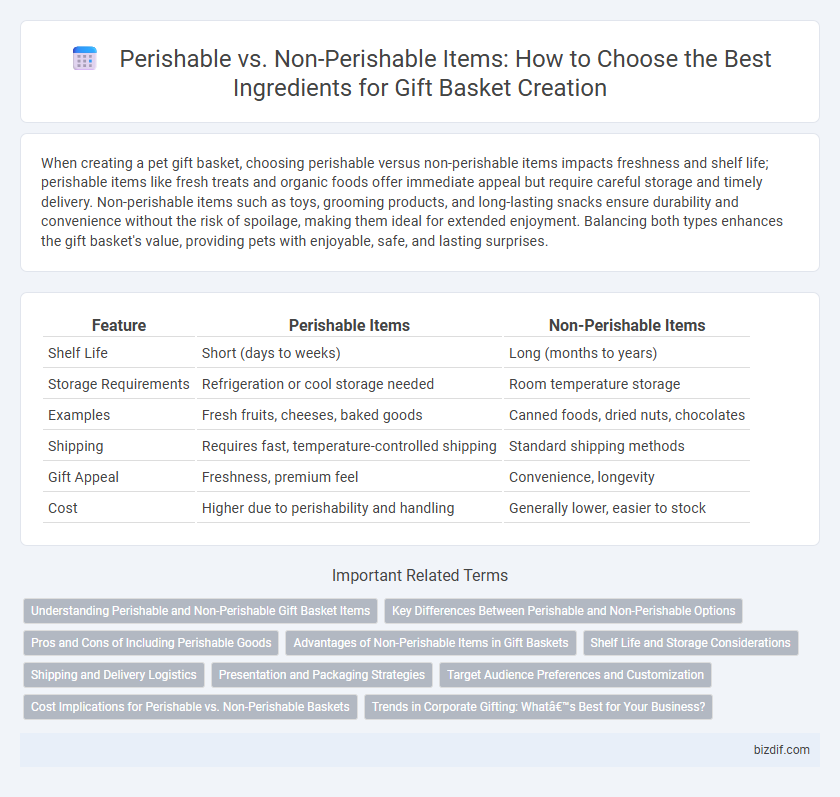When creating a pet gift basket, choosing perishable versus non-perishable items impacts freshness and shelf life; perishable items like fresh treats and organic foods offer immediate appeal but require careful storage and timely delivery. Non-perishable items such as toys, grooming products, and long-lasting snacks ensure durability and convenience without the risk of spoilage, making them ideal for extended enjoyment. Balancing both types enhances the gift basket's value, providing pets with enjoyable, safe, and lasting surprises.
Table of Comparison
| Feature | Perishable Items | Non-Perishable Items |
|---|---|---|
| Shelf Life | Short (days to weeks) | Long (months to years) |
| Storage Requirements | Refrigeration or cool storage needed | Room temperature storage |
| Examples | Fresh fruits, cheeses, baked goods | Canned foods, dried nuts, chocolates |
| Shipping | Requires fast, temperature-controlled shipping | Standard shipping methods |
| Gift Appeal | Freshness, premium feel | Convenience, longevity |
| Cost | Higher due to perishability and handling | Generally lower, easier to stock |
Understanding Perishable and Non-Perishable Gift Basket Items
Perishable gift basket items, such as fresh fruits, cheeses, and baked goods, require careful handling and prompt delivery to maintain quality and safety. Non-perishable items, including nuts, chocolates, and gourmet preserves, offer longer shelf life and greater flexibility in shipping and storage. Understanding the distinction between these categories ensures optimal selection and presentation for personalized gift baskets.
Key Differences Between Perishable and Non-Perishable Options
Perishable items in gift baskets, such as fresh fruits, cheeses, and baked goods, require refrigeration and have a limited shelf life, making prompt delivery essential to maintain quality. Non-perishable items like chocolates, nuts, and canned goods offer longer shelf stability and are less sensitive to temperature changes, allowing more flexible shipping and storage options. Understanding these key differences helps in selecting appropriate products for gift baskets based on recipient needs and delivery timelines.
Pros and Cons of Including Perishable Goods
Including perishable items in gift baskets enhances freshness and appeal, offering fruits, cheeses, and baked goods that provide a personalized touch and gourmet quality. However, perishable goods have a limited shelf life, requiring careful handling, timely delivery, and refrigeration, which increases costs and logistical complexity. Non-perishable items, such as chocolates and nuts, offer longer storage, easier shipping, and reduced spoilage risk, but may lack the immediacy and vibrancy that perishable goods bring to a gift basket.
Advantages of Non-Perishable Items in Gift Baskets
Non-perishable items in gift baskets offer extended shelf life, ensuring the contents remain fresh and usable for weeks or even months without refrigeration. These items provide greater flexibility in shipping and storage, reducing the risk of spoilage during transit and enabling easy customization to suit the recipient's preferences. The durability of non-perishable goods enhances the overall value and presentation of gift baskets, making them ideal for long-distance gifting and diverse occasions.
Shelf Life and Storage Considerations
Perishable items in gift baskets, such as fresh fruits, cheeses, and baked goods, have a limited shelf life typically ranging from a few days to two weeks and require refrigeration to maintain quality and prevent spoilage. Non-perishable items like nuts, dried fruits, chocolates, and packaged snacks offer an extended shelf life of several months to over a year and can be stored at room temperature without significant risk of degradation. Proper storage conditions are crucial to preserve the freshness and safety of perishable goods, while non-perishables are ideal for longer-lasting gift baskets suited for shipping and delayed consumption.
Shipping and Delivery Logistics
Perishable items in gift baskets require expedited shipping and temperature-controlled packaging to maintain freshness during transit, significantly increasing delivery costs and complexity. Non-perishable items offer greater flexibility in shipping options, allowing for standard delivery methods without special handling requirements. Efficient logistics for gift baskets prioritize product integrity and customer satisfaction by balancing item perishability with cost-effective transportation solutions.
Presentation and Packaging Strategies
Perishable items in gift baskets demand airtight, temperature-controlled packaging to maintain freshness and visual appeal, utilizing materials like insulated liners and biodegradable gel packs. Non-perishable items allow for greater flexibility in presentation, often showcased through elegant wrapping paper, decorative boxes, or reusable containers that enhance durability while highlighting the basket's theme. Strategic layering and color coordination between perishables and non-perishables optimize the overall aesthetic, making the gift basket both visually attractive and practical for varying shelf lives.
Target Audience Preferences and Customization
Target audience preferences heavily influence the choice between perishable and non-perishable items in gift baskets, with gourmet food lovers favoring fresh fruits, artisanal cheeses, and handmade chocolates, while practical recipients prefer long-lasting, shelf-stable snacks, preserves, and specialty teas. Customization options include tailoring the basket contents based on dietary restrictions, seasonal availability, and individual taste profiles, ensuring maximum satisfaction and relevance. Balancing perishable items' freshness with non-perishable items' longevity enhances the gift basket's appeal and usability for diverse recipient needs.
Cost Implications for Perishable vs. Non-Perishable Baskets
Perishable items in gift baskets often incur higher costs due to limited shelf life, specialized packaging, and expedited shipping requirements to maintain freshness. Non-perishable items enable cost savings through bulk purchasing, standard packaging, and extended storage time without risk of spoilage. Choosing non-perishable contents significantly reduces waste and logistical expenses, optimizing overall budget management for gift basket creation.
Trends in Corporate Gifting: What’s Best for Your Business?
Perishable items such as fresh fruits, gourmet cheeses, and artisan chocolates are popular in corporate gifting for their impression of freshness and luxury, yet require careful timing and storage considerations. Non-perishable items like premium teas, coffee blends, and branded merchandise offer longevity and ease of distribution, making them reliable choices for businesses aiming for lasting brand visibility. Current trends show a growing preference for hybrid gift baskets combining perishable delicacies with durable keepsakes to balance immediate delight and sustained brand impact.
Perishable items vs non-perishable items Infographic

 bizdif.com
bizdif.com